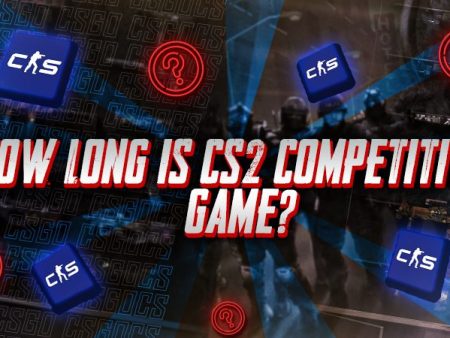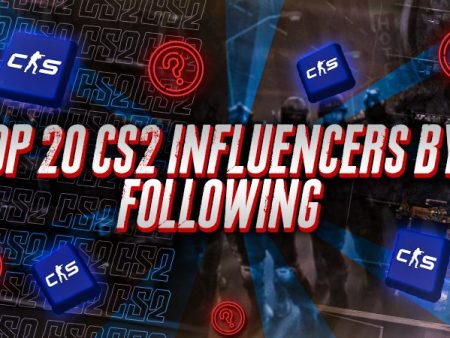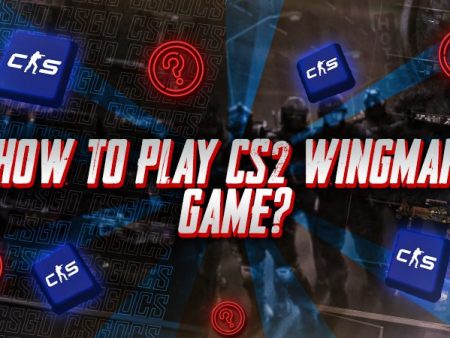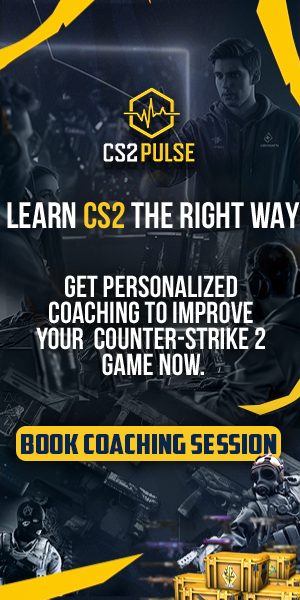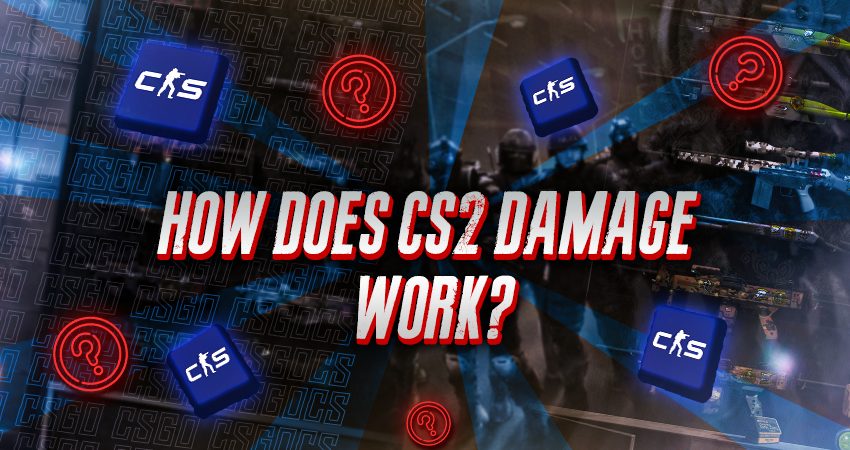
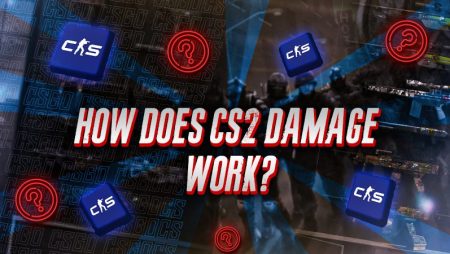
Every round in CS2 is about dealing damage before the other team does. Your choice of weapon, armor, and where you hit all change the outcome, but there’s more happening with every shot than most players realize. CS2’s damage system uses weapon stats, hit locations, armor values, and map factors to decide the results of each duel. Knowing how this works lets you make better decisions in every situation.
Understanding CS2 Damage
Landing shots isn’t enough if you want to win consistently. The way CS2 calculates damage comes down to more than just pulling the trigger.
This guide covers what really affects damage in each round:
- Weapon base damage
- How armor penetration changes fights
- Hitbox multipliers and why they matter
- How distance and cover affect shots
- Nades damage and usage
- Practical tips to increase damage
Let’s break down each factor, starting with weapon damage.
Weapon Base Damage
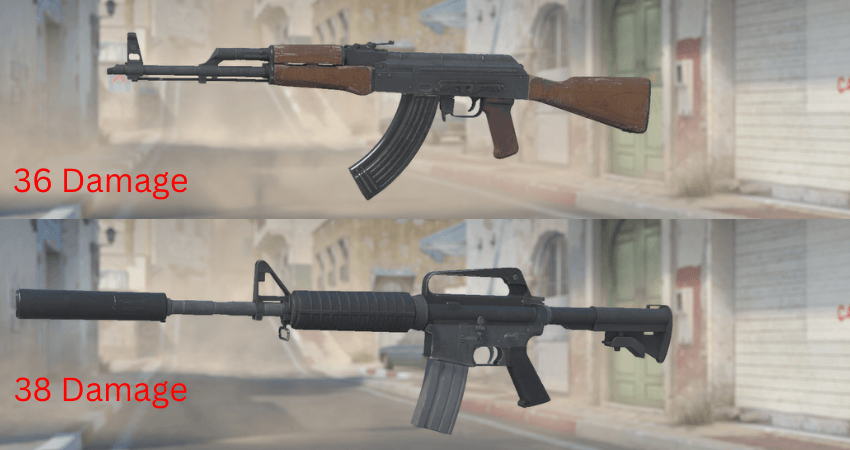
Every weapon in CS2 has a base damage value. This number is the starting point for every shot you take. Picking the right weapon for your position and round comes down to knowing these stats.
Examples:
- AK-47: Deals 36 base damage with 77.5% armor penetration and a fire rate of 600 RPM. A headshot kills instantly, even against armored opponents. At close range, 4 chest shots are needed to eliminate an armored enemy.
- M4A1-S: Provides 38 base damage with 70% armor penetration and excellent recoil control. Its silenced shots are effective for stealthier plays, but its slower fire rate demands accurate aiming. At close range, it requires 4 chest shots to kill an armored opponent.
- M4A4: Delivers 33 base damage with 70% armor penetration and a fire rate of 666 RPM. It’s versatile for spraying but less effective at long ranges due to lower damage. At close range, it takes 5 chest shots to kill an armored enemy, while 6 bullets are needed at long range.
- Galil AR: Features 30 base damage with 77.5% armor penetration, making it a cost-effective choice for Terrorists in low-economy rounds. At close range, it takes 5 chest shots to kill an armored opponent.
- FAMAS: Has 30 base damage and 70% armor penetration, with a reliable burst fire mode for precision. Against armored enemies, 5 chest shots are required at close range, while 7 shots are needed at long range.
- Desert Eagle: Offers 53 base damage and 93.2% armor penetration, allowing it to one-shot opponents with a headshot, even through helmets. Against armored enemies, it takes 3 chest shots at close range to secure a kill.
- AWP: Boasts 115 base damage with 97.5% armor penetration, making it one of the most powerful weapons in CS2. It guarantees an instant kill with a shot to the chest or head, but leg shots deal 85 damage.
- SSG 08 (Scout): Deals 88 base damage and is ideal for low-cost sniping with high mobility. A headshot guarantees a kill, while body shots require follow-ups. Against armored enemies, it takes 2 chest shots to eliminate the target.
Once you know how much damage your weapon can do, the next factor is how it handles enemy armor.
Armor Penetration
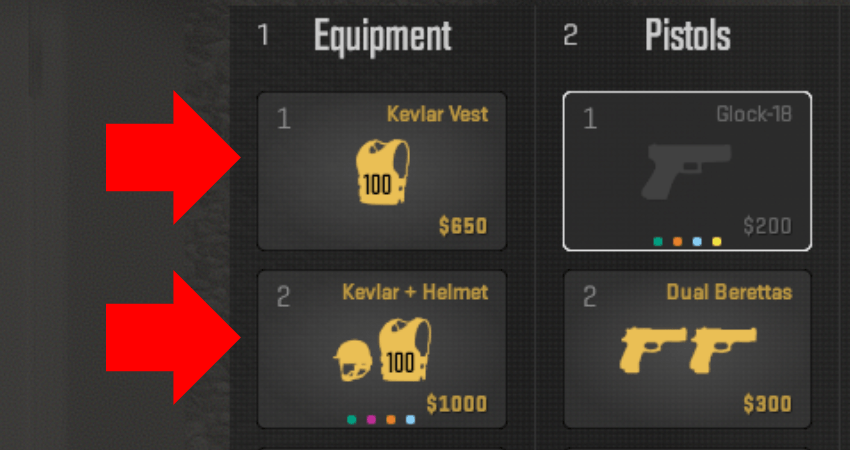
Armor reduces the damage you deal, but some weapons keep their stopping power. Choosing the right weapon is more important as your opponents buy more armor.
How much armor they beat:
- AK-47: 77.5% penetration. A headshot kills instantly, even through helmets, making it a reliable choice for Terrorists.
- M4A1-S: 70% penetration. Slightly less effective against armor than the AK-47, requiring an extra bullet in some situations.
- M4A4: 70% penetration. Similar armor performance to the M4A1-S but pairs it with a higher fire rate.
- Galil AR: 77.5% penetration. Matches the AK-47 in penetration but falls short in overall damage output.
- FAMAS: 70% penetration. A budget-friendly option but struggles to compete with higher-tier rifles against armored enemies.
- Desert Eagle: 93.2% penetration. Known for its ability to kill with one headshot, even against helmets, making it deadly in eco rounds.
- AWP: 97.5% penetration. Negligible damage reduction against armor, ensuring devastating hits in all scenarios.
- USP-S: 50.5% penetration. Effective at close range but significantly weaker against armor, requiring more precise shots to remain lethal.
- Glock-18: 47% penetration. Struggles against armored targets, especially in pistol rounds, but remains effective with accurate bursts.
The right weapon for the situation often comes down to how well it deals with armor. After penetration, where you hit the enemy can change the fight even more.
Hitbox Multipliers
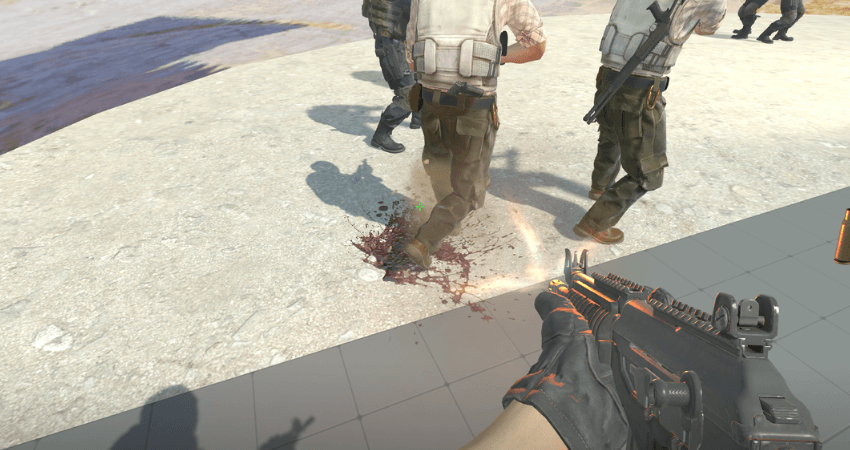
Hitboxes in CS2 represent specific regions of a player’s body, and each area applies its own damage multiplier, affecting how much damage is dealt with each shot. This system makes accurate aiming critical for effective gameplay.
- Head: The most vulnerable hitbox, delivering 400% damage. A headshot guarantees an instant kill with most weapons, even if the opponent is armored.
- Chest and Arms: Standard damage with a 100% multiplier, requiring more bullets to kill, especially against armored opponents.
- Stomach and Back: Deal slightly increased damage with a 125% multiplier, making these areas a better target than the chest when a headshot isn’t possible.
- Legs: The least effective hitbox, with a 75% damage multiplier. Shots to the legs often require significantly more bullets to eliminate a player.
Headshots always do the most damage. If you miss, hitting the stomach or back is better than the legs. Once you understand where to aim, map elements come into play.
[RELEVANT: How To Train Aim in CS2?]
Environmental Elements
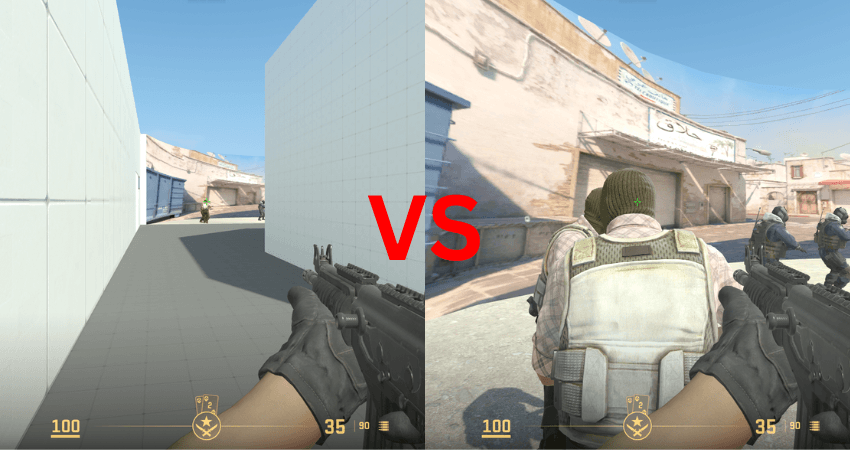
Environmental elements in CS2 significantly affect how much damage your weapons can deal. Factors like distance, obstacles, and bullet penetration influence your effectiveness in combat, making environmental awareness a critical aspect of gameplay.
- Distance: Most weapons experience damage drop-off over long distances. For example, SMGs like the MP9 are highly effective at close range but lose damage rapidly at a distance. Rifles like the AK-47 and AWP, on the other hand, maintain their damage output much better, making them ideal for long-range engagements.
- Obstacles: Objects such as wooden crates, doors, and walls reduce bullet damage when penetrated. Weapons with high penetration rates, like the AWP and SG 553, perform better through obstacles compared to SMGs or pistols. For instance, shooting through a thin wooden wall with the AWP can still result in a kill, while an SMG will deal significantly less damage.
- Vertical Positioning: Shooting from higher ground can offer a strategic advantage, providing better visibility and angles for headshots. It also reduces your exposure to enemies. Conversely, firing from a lower position can be less effective, as aiming upward often exposes you to counterattacks and decreases accuracy.
Every bullet can act differently depending on where you are and what’s between you and the target. This is why positioning and map knowledge matter as much as aim.
Nades Damage and Usage

Nades in CS2 are essential tools for both dealing damage and creating tactical advantages. Here’s how they work, with detailed information about their effects:
- HE Grenades deal a maximum of 98 damage with a direct hit against unarmored enemies, with slightly reduced damage against armored opponents. The blast radius extends up to 400 units, where damage scales based on proximity to the explosion. Enemies closer to the epicenter take significantly more damage than those at the edge. HE grenades are best for softening up enemies hiding in tight spaces or behind cover. When multiple grenades are stacked on the same target, they can eliminate enemies outright.
- Molotovs cause up to 40 damage per second to enemies standing in the flames, depending on how long they stay in the burning area. The fire lasts for around 7 seconds and spreads across a radius of 150-200 units, depending on the surface and throw angle. These grenades are ideal for forcing enemies out of defensive positions or denying access to chokepoints while dealing consistent damage to anyone caught in the flames.
- Flashbangs do not inflict damage but blind enemies within a radius of 500 units. The duration of the effect ranges from 1-2 seconds for full blindness, with partial blindness lasting up to 5 seconds depending on proximity. Flashbangs are best used to disorient enemies, making them vulnerable to follow-up attacks.
- Smokes do not deal any damage but create a smoke screen within a radius of 250 units, lasting approximately 15 seconds. They are crucial for blocking enemy sightlines, enabling safe movement across open areas, or creating cover for planting or defusing the bomb.
- Decoys cause minimal damage, about 5 damage if a direct hit lands on an enemy. Their primary effect is to mimic gunfire sounds and distract opponents. When they explode after a short time, they deal negligible damage in a small radius. Decoys are most effective for misdirection or baiting enemies into traps.
Learning nades usage in CS2 involves understanding their specific damage outputs and tactical applications. Whether it’s maximizing damage with HE grenades or controlling areas with Molotovs, grenades are versatile tools that can significantly influence the outcome of a round.
Practical Tips to Increase Damage
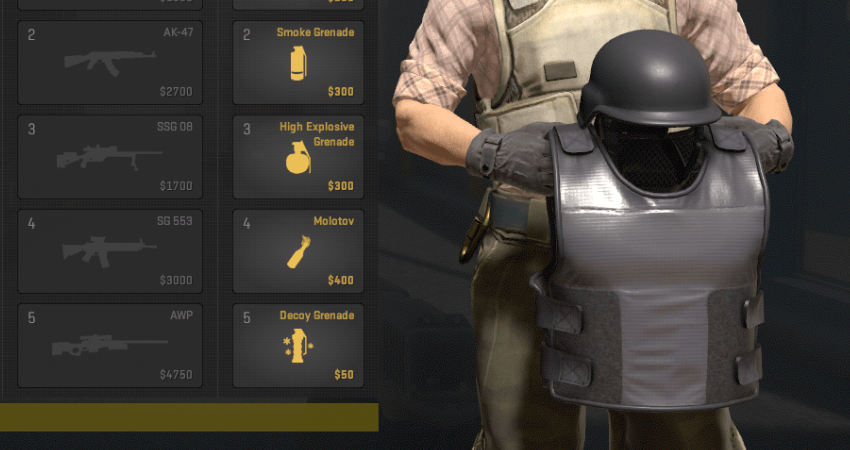
To get better results, you need to combine everything above into your play. Smart choices and consistent practice will make a difference.
- Aim for the Head: A headshot is the fastest way to take down an opponent.
- Master Spray Control: Learn each weapon’s recoil pattern to land more shots.
- Position Smartly: Use maps to secure angles where you can strike first.
- Choose the Right Weapon: Match your weapon to the situation and your economy.
- Always Buy Armor: The extra protection can make the difference in close fights.
Each small change adds up over time. The more you understand about damage, the better your results will be.
[RELEVANT: How To Get Better in CS2?]
Summary
| Topic | Key Points |
|---|---|
| Weapon Base Damage | Each gun has a base damage value; examples include AK-47 (36), M4A1-S (38), Desert Eagle (53), and AWP (115). |
| Armor Penetration | Determines how much damage passes through Kevlar; Desert Eagle (93.2%) and AWP (97.5%) have highest penetration. |
| Hitbox Multipliers | Damage varies by body part: head (400%), stomach/back (125%), chest/arms (100%), legs (75%). |
| Environmental Factors | Distance reduces SMG/shotgun damage more; obstacles weaken bullets unless using high-penetration rifles; positioning affects hit accuracy. |
| Grenade Damage | HE Grenade can deal up to 98 damage; Molotov causes 40 damage per second; flashbangs blind, smoke blocks vision, decoy distracts with minor damage. |
| Tips to Increase Damage | Aim for headshots, learn spray patterns, use map angles, buy suitable weapons, always buy armor, and use cover and grenades smartly. |
Conclusion
Damage in CS2 comes down to weapon stats, armor, hitboxes, and the map itself. Learning how these work together means you can take more control of your fights. Make these mechanics part of how you play, and you’ll see better results each game.
